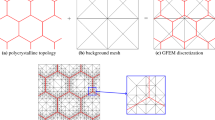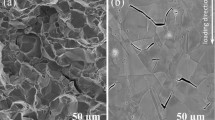Abstract
Fracture nanomechanics is the study of the interconnected process of the growth and birth of cracks and dislocations in the nanoscale. In this paper, it is applied to superplasticity and fatigue of metals and other polycrystalline materials in order to derive the basic equations describing some main features of these phenomena, namely, the fatigue threshold and the enormous neck-free superplastic elongation. It is shown that in most metals and alloys the fatigue threshold is greater than one per cent of the value of fracture toughness. Using the concepts of fracture nanomechanics, we study the superplastic deformation and fracturing of polycrystalline materials under uniaxial extension and calculate the neck-free elongation to failure in terms of strain rate, stress and temperature. Then, we determine the optimum strain rate of the maximum superplastic elongation in terms of temperature, creep index and other material constants. Further, we estimate the critical size o f ultrafine grains necessary to stop the growth of microcracks and open way to the superplastic flow, and find the superplastic deformation of grains, their maximum-possible elongation and the activation energy of superplastic state. Also, we introduce the dimensionless A-number in order to characterize the capability of different materials in yielding the superplastic flow. A t a very high elongation the alloying boundary of grains proves to be broken by a periodical system o f dead fractures of some definite period. It is shown that experimental results of the testing of the Pb-62% Sn eutectic alloy and Zn-22% A l eutectoid alloy at T = 473 K have substantially supported the theory of superplasticity advanced herewith.
Similar content being viewed by others
References
Cherepanov, G.P., Cracks in Solids, Int. J. Solids Struct., 1968, vol. 4, no. 4, pp. 811–831.
Cherepanov, G.P., On the Crack Growth under Cyclic Loadings, J. Appl. Mech. Tech. Phys., 1968, no. 6, pp. 924–940.
Cherepanov, G.P. and Halmanov, H., On the Theory of Fatigue Crack Growth, J. Eng. Fract. Mech., 1972, vol. 4, no. 2, pp. 231–248.
Cherepanov, G.P., Mechanics of Brittle Fracture, Moscow: Nauka, 1974.
Cherepanov, G.P., Mechanics of Brittle Fracture, New York: McGraw–Hill, 1978.
Cherepanov, G.P., Fmcture Mechanics, Moscow: Institute of Computer Science, 2012.
Paris, P.C., Testing for Very Slow Growth of Fatigue Cracks, DEL Research Corporation. Closed Loop 2, 1970, no. 5, pp. 11–49.
Cherepanov, G.P., The Start of Growth of Micro–cracks and Dislocations, Sov. Appl. Mech., 1988, vol. 23, no. 12, pp. 1165–1183.
Cherepanov, G.P., The Growth of Micro–cracks under Monotonic Loading, Sov. Appl. Mech., 1988, vol. 24, no. 4, pp. 396–415.
Cherepanov, G.P., The Closing of Micro–cracks under Unloading and Generation of Reverse Dislocations, Sov. Appl. Mech., 1989, vol. 24, no. 7, pp. 635–648.
Cherepanov, G.P., On the Foundation of Fracture Mechanics: Fatigue and Creep Cracks in Quantum Fracture Mechanics, Sov. Appl. Mech., 1990, vol. 26, no. 6, pp. 3–12.
Cherepanov, G.P., Invariant Integrals in Continuum Mechanics, Sov. Appl. Mech., 1990, vol. 26, no. 7, pp. 3–16.
Cherepanov, G.P., Richter, A., Verijenko, V.E., Adali, S., and Sutyrin, V., Dislocation Generation and Crack Growth under Monotonic Loading, J. Appl. Phys., 1995, vol. 78, no. 10, pp. 6249–6265.
Cherepanov, G.P., Methods of Fracture Mechanics: Solid Matter Physics, Dordrecht: Kluwer, 1997.
Cherepanov, G.P., Nanofracture Mechanics Approach to Dislocation Generation and Fracturing: Invited Paper at the 12th U.S. Nat. Congr. Appl. Mech., Appl. Mech. Rev., 1994, vol. 47, no. 6, part 2, S326.
Padmanabhan, K.A. and Davis, G.J., Superplasticity: Mechanical and Structural Aspects, Environmental Effects, Fundamentals and Applications, Berlin: Springer Verlag, 1980.
Encyclopedia of Physics, Lerner, R.G., Trigg, G.L., Eds., New York: VCH Publ., 1990.
Honeycomb, R.W.K., Plastic Deformations of Metals, London: Edward Arnold Publ., 1968.
Kawasaki, M. and Langdon, T.G., Grain Boundary Sliding in a Superplastic Zinc–Aluminum Alloy Processed Using Severe Plastic Deformation, Mater. Trans., 2008, vol. 49, no. 1, pp. 84–89.
Author information
Authors and Affiliations
Corresponding author
Additional information
Russian Text © G.P. Cherepanov, 2018, published in Fizicheskaya Mezomekhanika, 2018, Vol. 21, No. 6, pp. 55–65.
Rights and permissions
About this article
Cite this article
Cherepanov, G.P. Theory of Superplasticity and Fatigue of Polycrystalline Materials Based on Nanomechanics of Fracturing and Failure. Phys Mesomech 22, 52–64 (2019). https://doi.org/10.1134/S1029959919010090
Received:
Revised:
Accepted:
Published:
Issue Date:
DOI: https://doi.org/10.1134/S1029959919010090




